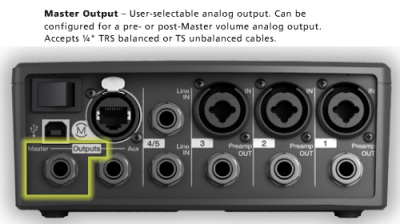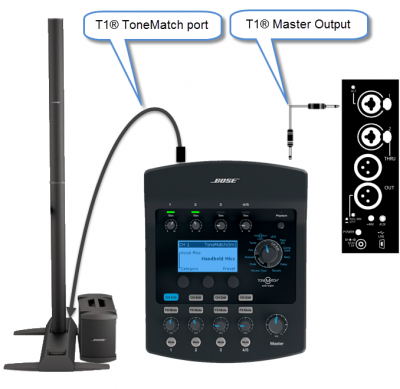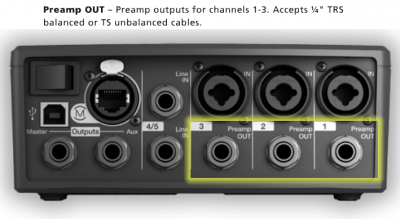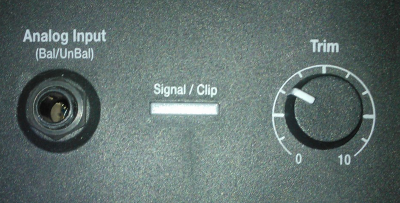TC-Helicon VoiceSolo FX150
|
This article is an editorial and expresses the opinion and experience of the author. Please post comments in the Bose Professional Portable Systems Forum.
|
The TC-Helicon VoiceSolo FX150 is an personal monitor system that attaches to a microphone stand. It can be used in other ways, but we'll talk about using it as a personal monitor. The L1 systems were designed to be positioned behind the performer and when used as designed there is no need for a monitors. For more more information on that concept see: The L1® Approach and the History Of Amplification. I have a TC-Helicon VoiceSolo FX150. It is at least as good as the similarly sized personal monitors from Mackie and Behringer. When I use my L1® systems I don't need monitors. However I got my TC-Helicon VoiceSolo FX150 as part of promotional deal and I was glad to have the opportunity to try it first hand.
As simple as it is to set up, it's more trouble than it's worth. On the microphone stand, I have found it too prone to feedback. I can't get the volume up high enough to be heard over the L1 . I might consider using it in a situation where I had to place the {{L1} in a position where I could not hear it. But for me, that almost never happens. After a lot of experimenting I just don't use with it when I have my Model II or Compact. I use it when the L1 Compact would make too much of a visual impact. For example - at an acoustic jam where I've brought my Yamaha Silent Guitar. At these events amps are not welcome, but I can get away with the smaller TC-Helicon VoiceSolo FX150. I have used it with a wireless microphone for small speaking gigs but I have to be careful about feedback. In small rooms for 15-20 people the TC-Helicon VoiceSolo FX150 has been fine. I had a series of gigs on a walking campus where I had to haul everything I needed in one trip. Even the 30 pound L1 Compact would have been too much to carry and the 7 pound TC-Helicon VoiceSolo FX150 was up to the task. If you're thinking of buying one to use with an L1 system I suggest that you rent or borrow one, or try one out someplace where you can run it in front of a Model II first.
My renewed interest in the VoiceSolo FX150 was because of the announcement about the F1 Flexible Array Loudspeaker System. It's pretty clear that the F1 is meant to be used with monitors so I started looking around here to see what I have. I've got the VoiceSolo FX150 above and some good old Bose 802s. The 802s sit nicely in the front cover and can be tipped back and used as floor wedges. I used to do that back in the pre-L1 days. While the VoiceSolo FX150 hasn't added much for me on an L1 stage, it may have a place on an F1 stage. |
TC-Helicon Adaptive Tone (Voice Tone)
The TC-Helicon VoiceSolo FX150,like many other products from TC-Electronics has a feature called Adaptive Tone (activated by the Voice Tone button).
- Adaptive Tone™ for Intelligent EQ, Compression, De-essing and Gating.
- The Vocal Tone button is like having your own professional vocal sound tech automatically dialing in flattering EQ, compression and de-essing – matched to your voice.
Source
Note: Using a vocal microphone with Voice Tone AND a Bose Preset for a vocal microphone will reduce gain-before-feedback.
When I have turned on the Voice Tone feature this caused a drop in output.
Application Notes
T1 ToneMatch Audio Engine
If you are using a T1 ToneMatch Audio Engine connected to a L1 Model II or L1 Model 1S then the simplest approach is to connect your microphone and other sources directly to the T1 ToneMatch Audio Engine as you normally would, and then connect the T1 ToneMatch® Audio Engine Master output to the TC-Helicon VoiceSolo FX150 channel 1 input.T1 Preamp Outputs
The T1 Preamp Outputs are post-trim only. That is: there is no signal processing at the Preamp Outputs. There are no Presets, EQ, or effects. So there is no particular advantage to using the Preamp outputs as the source for the TC-Helicon VoiceSolo FX150 unless you want to use the TC-Helicon VoiceSolo FX150 effects. The disadvantage is that you will not be hearing the mix that is going to the Power Stand (what the audience will hear).Connecting Directly to a Power Stand
If you have a T1® you will have far more control and more effects if you use the T1®.Use the T1® as your main processor and run the T1® Master Output to the TC-Helicon VoiceSolo FX150.
If you don't have a T1® you can try connecting your input sources (microphone, guitar) to the TC-Helicon VoiceSolo FX150 and running the output directly to a L1 Model II or L1 Model 1S Power Stand Analog Input. You will need an XLR to ¼ inch jack Tip-Ring-Sleeve adapter. See the detailed notes below for the Compact for information about adapter and cables.
L1 Compact
If you are not using a T1 ToneMatch Audio Engine you can connect your vocal microphone and instrument directly to the TC-Helicon VoiceSolo FX150. Then connect the VoiceSolo FX150 XLR output to an XLR to ¼ inch jack Tip-Ring-Sleeve cable, and connect that to Compact Channel 2. Set the ToneMatch switch Line Level (down position).TC-HeliconVoiceSolo FX150 to L1® Compact
Do not connect the TC-Helicon VoiceSolo FX150 to Compact Channel 1 because Compact Channel 1 has a built-in Preset for Vocal Microphones.







